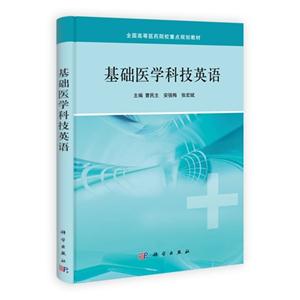扫一扫
关注中图网
官方微博
本类五星书更多>
-
>
中医入门必背歌诀
-
>
医验集要
-
>
寻回中医失落的元神2:象之篇
-
>
补遗雷公炮制便览 (一函2册)
-
>
人体解剖学常用词图解(精装)
-
>
神医华佗(奇方妙治)
-
>
(精)河南古代医家经验辑
基础医学科技英语 版权信息
- ISBN:9787030377227
- 条形码:9787030377227 ; 978-7-03-037722-7
- 装帧:一般胶版纸
- 册数:暂无
- 重量:暂无
- 所属分类:>>
基础医学科技英语 本书特色
曹民主、安强梅、张宏斌主编的这本《基础医学科技英语》取材于部分国外教材,根据内容系统和实际需要重新整理,编撰为20章,涉及人体所有的系统,涵盖了解剖、生理、病理、预防与治疗、环境与健康、保健与锻炼等方面的知识内容。全书语言地道,准确简练,规范实用。基础医学阶段的英语词汇覆盖面达90%。本书英语用法表述严谨生动,科学性、知识性、趣味性、探索性一应俱全。本书不仅提供和展示了学习专业英语的平台,更可使读者对自己学过的基础医学知识进行完整系统的全面回顾、加固、综合、融汇、贯通和应用。
基础医学科技英语 内容简介
本书共20章, 涉及解剖、生理、病理、预防与治疗、环境与健康、保健与锻炼等方向的知识, 每章除了专业性文章外, 还列出生词、词组、典型句分析与翻译等。
基础医学科技英语 目录
前言 ForewordChapter 1 The General Plan of the Human Body 1.1 What are Living Things Made of 1.2 Body Systems 1.3 Directions in the Body 1.4 Body Cavities 1.5 The Metric SystemChapter 2 Disease and Disease-producing Organisms 2.1 What is Disease 2.2 The Study of Disease 2.3 Disease Terminology 2.4 Infection 2.5 The Microorganisms 2.6 Microbial Control 2.7 Laboratory Identification of PathogensChapter 3 Chemistry of Life 3.1 What is Chemistry 3.2 A Look at Atoms 3.3 Molecules,Elements,Compounds and Mixtures 3.4 Ions and Electrolytes 3.5 Acids and Bases 3.6 The Chemistry of Living MatterChapter 4 Cell Structure and Function 4.1 Cellular Organization 4.2 Crossing the Plasma 4.3 The Cell CycleChapter 5 Body Tissues and Membranes 5.1 Epithelial Tissue 5.2 Connective Tissue 5.3 Muscular Tissue 5.4 Nervous Tissue 5.5 ExtracellularJunctions,Glands,and MembranesChapter 6 The Blood 6.1 Purposes of the Blood 6.2 Blood Constituents 6.3 Origin of the Corpuscles 6.4 Blood Clotting 6.5 Uses of Blood Derivatives 6.6 Blood Disorders 6.7 Blood Studies 6.8 Blood Chemistry Tests 6.9 Other Blood TestsChapter 7 The Heart and the Heart Disease 7.1 Circulation and the Heart 7.2 Structure of the Heart 7.3 Physiology of the Heart 7.4 Heart Disease 7.5 Prevention of Heart Ailments 7.6 Some Practical Aspects of TreatmentChapter 8 Blood Vessels and Blood Circulation 8.1 Kinds of Blood Vessels 8.2 Structure of Blood Vessels 8.3 Names of Systemic Arteries 8.4 Names of Systemic Veins 8.5 How Capillaries Work 8.6 Pulse and Blood Pressure 8.7 Disorders Involving the Blood Vessels 8.8 Replacement of ArteriesChapter 9 Bones,Joints and Muscles 9.1 The Musculoskeletal System 9.2 The BonesChapter 10 The Integumentary System 10.1 Structure of the Skin 10.2 Accessory Structures of the Skin 10.3 Disorders of the Skin 10.4 Effects of Aging 10.5 HomeostasisChapter 11 Respiration 11.1 Respiration 11.2 The Respiratory System 11.3 The Lung Cavities 11.4 Physiology of Respiration 11.5 Disorders of the Respiratory System 11.6 Some Practical Aspects of Ventilation 11.7 Special Equipment for Respiratory Tract TreatmentsChapter 12 Digestion and Indigestion 12.1 What the Digestive System Does 12.2 The Alimentary Canal 12.3 The Accessory Structures 12.4 The Peritoneum 12.5 Some Practical Aspects of NutritionChapter 13 Urinary System and Excretion 13.1 Urinary System 13.2 Anatomy of the Kidney and Excretion 13.3 Regulatory Functions of the Kidneys 13.4 Problems with Kidney Function 13.5 Effects of AgingChapter 14 The Endocrine System 14.1 Endocrine Glands 14.2 Hypothalamus and Pituitary Gland 14.3 Thyroid and Parathyroid Glands 14.4 Adrenal Glands 14.5 Pancreas 14.6 Other Endocrine Glands 14.7 Chemical Signals 14.8 Effects of Aging 14.9 HomeostasisChapter 15 The Brain,the Spinal Cord and the Nerves 15.1 The Nervous System as a Whole 15.2 Nerves in General 15.3 Central Nervous System 15.4 The Peripheral Nervous System 15.5 The Autonomic Nervous System Chapter 16 The Sensory System 16.1 Sense and Sensory Mechanisms 16.2 The Eye 16.3 The Ear 16.4 Other Organs of Special Sense 16.5 General SensesChapter 17 Body Temperature and Its Regulation 17.1 Body Temperature and Homeostasis 17.2 Heat Production 17.3 Heat Loss 17.4 Temperature Regulation 17.5 Normal Body Temperature 17.6 Abnormal Body Temperature 17.7 Effects of ExtremeChapter 18 The Lymphatic System and Body Defenses 18.1 Lymphatic System 18.2 Organs,Tissue and Cells of the Immune System 18.3 Nonspecific and Specific Defenses 18.4 Induced Immunity 18.5 Effects of Aging 18.6 HomeostasisChapter 19 Reproduction 19.1 Male Reproductive System 19.2 Female Reproductive System 19.3 Pregnancy 19.4 The MenopauseChapter 20 Human Genetics 20.1 Chromosomal Inheritance 20.2 Down Syndrome 20.3 Too Many/Too Few Sex Chromosomes 20.4 Genetic Inheritance 20.5 DNA TechnologyMedical TerminologyKey to the Exercises参考文献 References
展开全部
书友推荐
- >
唐代进士录
唐代进士录
¥16.1¥39.8 - >
新文学天穹两巨星--鲁迅与胡适/红烛学术丛书(红烛学术丛书)
新文学天穹两巨星--鲁迅与胡适/红烛学术丛书(红烛学术丛书)
¥9.9¥23.0 - >
我与地坛
我与地坛
¥16.4¥28.0 - >
随园食单
随园食单
¥16.4¥48.0 - >
烟与镜
烟与镜
¥18.3¥48.0 - >
罗曼·罗兰读书随笔-精装
罗曼·罗兰读书随笔-精装
¥32.9¥58.0 - >
大红狗在马戏团-大红狗克里弗-助人
大红狗在马戏团-大红狗克里弗-助人
¥5.2¥10.0 - >
莉莉和章鱼
莉莉和章鱼
¥14.4¥42.0
本类畅销
-
方剂学
¥48.4¥79 -
系统解剖学
¥44.4¥79 -
方剂学
¥68.9¥79 -
中医基础理论习题集·全国中医药行业高等教育“十四五”规划教材配套用书
¥76.8¥96 -
中医内科学
¥28.8¥48 -
血液学检验(第5版/高职检验/配增值)
¥45.9¥69
浏览历史
Visio绘图软件标准教程(全彩微课版)/清华电脑学堂
¥46.4¥69.8基础模块-财经应用数学
¥9.5¥25.0优秀学生超爱玩的数学游戏大全-超级大脑
¥13.7¥28.0海豚传媒:西游记.第八卷(幼儿注音美绘本)
¥8.8¥19.9为什么月亮不会掉下来
¥9.8¥25.0

















